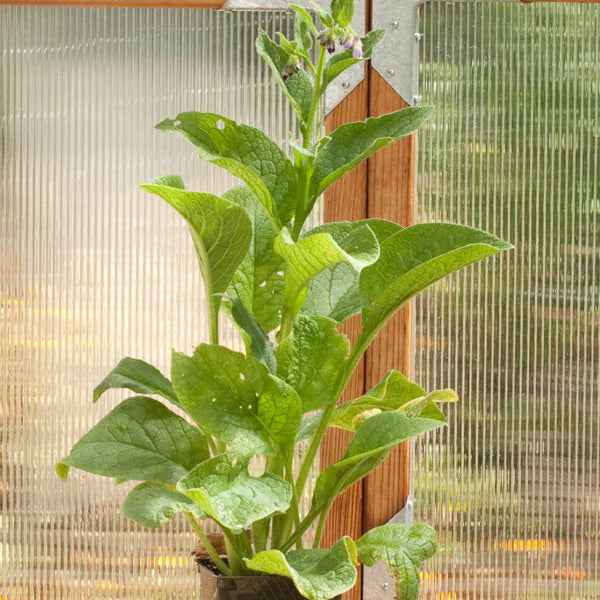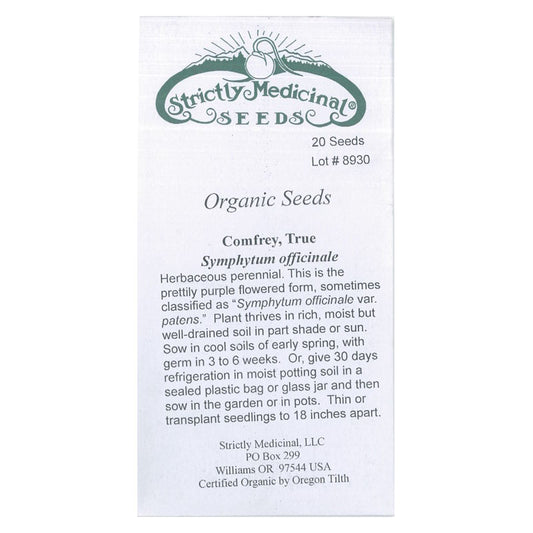We’re Signers of the Safe Seed Pledge!
All of our Peaceful Valley brand vegetable seed packs are CCOF & USDA Certified Organic, in addition to being Non-GMO and Open-Pollinated (with the exception of hybrid seeds).

4.75 / 5.0
(8) 8 total reviews

Comfrey, scientifically known as Symphytum officinale, is a versatile and valuable herbaceous plant belonging to the borage family. This drought-tolerant plant, often referred to as common comfrey, is native to Europe and has become naturalized in other parts of the world, including North America. Symphytum officinale is known for its distinctive appearance and diverse uses, including medicinal and ornamental purposes. Comfrey prefers well-drained soil and ample space, making it ideal for gardens where mature plants can thrive. Its ability to decrease quantity when grown in crowded conditions highlights the importance of giving these space plants adequate room to flourish.
Comfrey seeds, specifically Symphytum officinale, are a fantastic addition to any garden, offering numerous benefits from their hardy perennial nature to their versatility in various environmental conditions. As a drought-tolerant plant, comfrey can thrive in well-drained soil, whether in partial shade or full sun. It's known for its ability to break up compacted soils, enhance compost piles, and help manage weeds. Sow the seeds in warm potting soil or directly in the garden during spring for optimal germination, and enjoy the plant’s advantages throughout the growing seasons. As the true leaves develop, comfrey supports your garden's ecosystem by attracting bees, providing valuable nutrients for compost tea, and contributing to mulch, while its clumping growth pattern helps improve soil health and reduce winter damage.
Comfrey seeds are a key asset in sustainable gardening, offering numerous benefits that enhance garden health and productivity. As a hardy perennial growing in various conditions, including full sun and partial shade, comfrey is a drought-tolerant plant that thrives in well-drained soil and breaks compacted soils to improve garden structure. Its clumping herb comprised of multiple stalks contributes to rich mulch trees and a wonderful compost pile, while its ability to promote seed life and provide nutrient-rich compost tea makes it an excellent choice for gardeners looking to support their plants and improve soil health.
Comfrey seeds offer exceptional benefits for garden soil health, making them a valuable addition to any planting scheme. As a hardy perennial growing well in various conditions, including full sun and partial shade, comfrey excels in breaking compacted soils and improving soil structure with its deep root system. The clumping herb comprised of multiple stalks contributes to a rich mulch pile and promotes seed life by enhancing soil fertility, making it an ideal companion plant for creating a sustainable and thriving garden environment.
Comfrey is a robust plant that typically reaches a height of two to four feet. Its striking pink, purple, or white flowers grace the plant from June to August, making it an attractive addition to gardens and landscapes. The leaves of the comfrey plant are large, covered in fine hairs, and known for their rough texture. Additionally, comfrey produces small, black fruits that contain its seeds. These botanical features contribute to the plant's overall charm and appeal.
When it comes to growing comfrey from seeds, it's important to note that true comfrey seeds can be patient germinators, taking up to 30 days to sprout. Gardeners should exercise patience and provide the necessary care during this germination period. Once established, comfrey is a remarkably hardy plant, capable of withstanding temperatures as low as -15 degrees Fahrenheit. Its resilience against harsh conditions makes it a valuable addition to various climates.
To successfully grow comfrey from seeds, start by preparing your garden with well-drained soil and a sunny to partially shaded location. Soak your comfrey seeds for up to three weeks to enhance germination, then plant seed in warm potting soil, lightly covering them to promote seed life. As your comfrey plants begin to sprout, provide them with gentle and warm light and keep the soil moist but not waterlogged. Once established, these hardy perennial plants will thrive in various environmental conditions and contribute to your garden's health by breaking compacted soils and enriching the compost pile. For optimal results, follow our detailed growing instructions included with your seed envelope and enjoy the benefits of these drought-tolerant plants in your yard.
Comfrey has a rich history of medicinal applications* that dates back centuries. Both the plant's roots and leaves contain compounds believed to possess healing properties. One of the most common uses of comfrey is the creation of poultices. These poultices, made from crushed comfrey leaves or roots, are applied topically to treat a range of ailments. They are said to be particularly effective in soothing bruises, relieving joint pain, and reducing inflammation. Comfrey's potential as a natural remedy for these conditions has contributed to its enduring popularity in traditional medicine.
Comfrey tea is another avenue through which this plant offers health benefits. When brewed and consumed, comfrey tea is believed to aid in digestion and alleviate respiratory congestion. The soothing properties of comfrey extend beyond topical applications, making it a valuable herb in holistic wellness practices.
Beyond its medicinal virtues, comfrey has also earned its place as an ornamental plant. The colorful and vibrant flowers that adorn the comfrey plant during the summer months make it an attractive choice for gardens and landscapes. The tall and sturdy stalks, crowned with various hues, create eye-catching displays that delight garden enthusiasts and pollinators alike. Comfrey's dual role as both a functional herb and an ornamental addition makes it a valuable asset in various gardening endeavors.
Comfrey, with its distinctive appearance, versatile uses, and resilience, is a plant that offers much to both gardeners and herbalists alike. Whether you are drawn to its captivating bloom, seek its medicinal benefits, or wish to enhance your garden's aesthetics, comfrey is a versatile and enduring choice. This plant is known for its ability to germinate quickly, providing essential nutrients to your garden soil and helping to manage weeds. Its adaptability in different climates, including its robust performance during summer, and its use in herbal remedies and as feed for livestock, make it a valuable addition to any garden. As you explore the world of comfrey, you’ll discover a plant that continues to thrive and provide value, whether through its harvestable leaves or its role in enriching your garden's ecosystem.
See our full collection of organic and non-GMO herb seeds.
Not medical advice. See a physician for more information.
Choose our organic and non-GMO comfrey seeds for your garden to ensure a thriving and sustainable planting experience. Our current stock includes robust varieties such as the Russian comfrey, perfect for creating a diverse and healthy garden. With their ability to grow in full sun or partial shade and their role in breaking compacted soils while providing wonderful compost tea, these hardy, drought-tolerant plants are a must-have for any eco-friendly garden. Sow the seeds now to enjoy their benefits throughout the growing season, from enhancing soil health to boosting garden productivity. Don't miss out on the opportunity to enhance your garden's health and productivity—purchase our comfrey seeds today and experience the benefits of these plants as they spread and flourish in your yard!
How should I plant comfrey seed for the best results?
To plant comfrey seed, soak seeds overnight to enhance germination. Then, lightly cover them with soil in a pot or directly in the ground. Comfrey thrives in full sun or partial shade and germinate best in moist but well-drained soil.
Can comfrey grow in most soils?
Yes, Symphytum officinale can grow in most soils, including compacted soil. However, it prefers organic matter-rich soil and can be planted near shrubs or bee balm to maximize its growth potential.
When should I expect my comfrey to sprout?
After planting, comfrey seed may take several weeks to sprout. With proper care, such as maintaining moist soil, seedlings should appear during the growing seasons. Established plants may show more vigorous growth the following spring.
Can comfrey grow in both full sun and partial shade?
Yes, comfrey can be planted in both full sun and partial shade, although it tends to flourish more in moderate light. Ensuring the plant receives enough sunlight will encourage healthy flowers and overall growth.



Every delivery’s carbon footprint is calculated based on weight, shipping method, and distance traveled. We neutralize these emissions by purchasing verified carbon removal credits from groundbreaking projects.



With your purchase, you’ll join a community of proactive merchants and customers dedicated to a sustainable future. Together, we've removed emissions for over 44 million deliveries and removed over 31 thousand tonnes of carbon.

We work with a network of pioneering carbon removal companies that have been vetted by the commerce platform Shopify.



